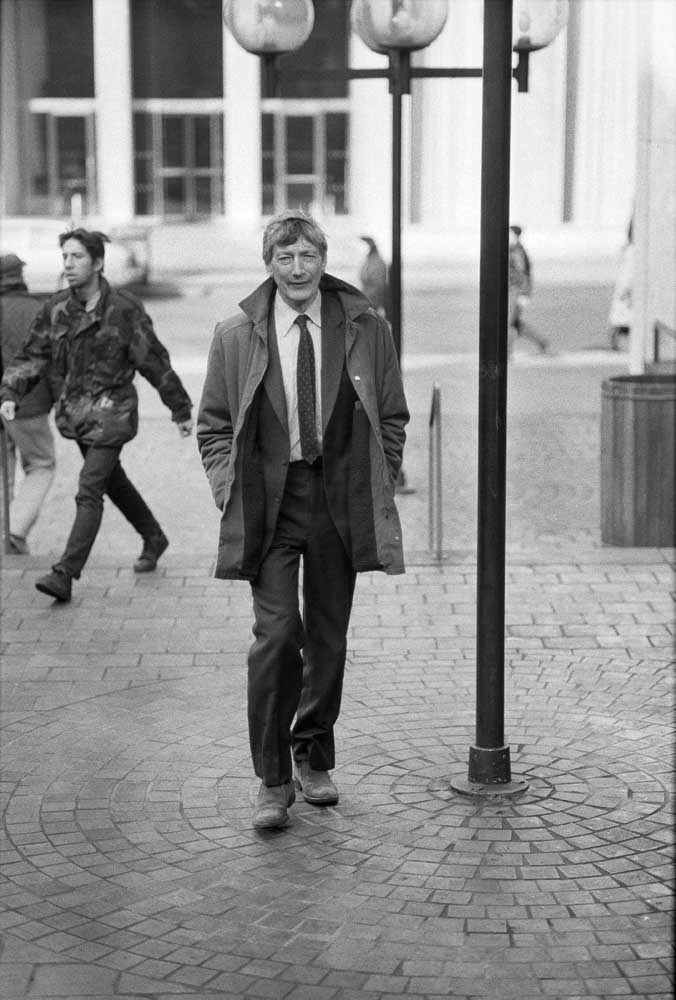Peter Dickinson was a master plotter who always relished a good puzzle

- Jack Manning / The New Yorki Times file photoPeter Dickinson, an award-winning British mystery writer, seen here in a photo from the 1980s, died Wednesday in Winchester, near the southern coast of England. It was his 88th birthday.
Published 12:00 am Saturday, December 19, 2015
Peter Dickinson, an award-winning British mystery writer whose books for adults and children often crossed the boundaries separating the genres of crime, adventure, science fiction, fantasy and suspense, died Wednesday, his 88th birthday, in Winchester, Hampshire, England.
His death was confirmed by his daughter Philippa Dickinson.
Dickinson, who wrote nearly 60 novels, was a late starter who did not publish his first novel until he was nearly 40.
In the late 1960s, as an assistant editor at the humor magazine Punch, he had been reviewing mystery novels for several years when an idea came to him. As he told The Guardian of London, “I had a picture of a tribesman lying dead on a bare floor in a room in London, with a lamp at his feet and a wake going on around him, and from that I got this corking idea which you could hardly go wrong with, provided you could make up a tribe realistically.”
The result, “Skin Deep,” told the story of a fictional New Guinea tribe, the Ku, whose last surviving members are brought by a wealthy sponsor to London. There their chief is murdered, presenting Inspector James Pibble of Scotland Yard with a real puzzler.
The Crime Writers’ Association gave the novel its Gold Dagger award for the best mystery of the year. (It was published in the United States in 1968 as “The Glass-Sided Ants’ Nest.”)
Unusual sleuths
Pibble, an aging, rather unprepossessing figure — Dickinson described him as “honourable but having resigned himself to the fact that he is not the tops” — appeared in several more novels, winding up in an old-age home and struggling with dementia in the final book in the series, “One Foot in the Grave” (1979).
Dickinson’s appetite for arcane knowledge and his taste for unusual situations, often those from the past, made him a highly unpredictable genre writer.
In “The Poison Oracle” (1974), the palace zookeeper in a mythical Middle Eastern kingdom must draw on his language work with chimpanzees to solve a crime. In two comic mysteries, “King and Joker” (1976) and “Skeleton-in-Waiting” (1989), Dickinson invented a Britain ruled by a democratized royal family. In “Some Deaths Before Dying” (1999), a 90-year-old sleuth must solve a crime whose principal players are dead, near dead or suffering from dementia.
“Dickinson is one of the most natural and literate of mystery writers,” Harold Schonberg, under the pen name Newgate Callendar, wrote in The New York Times Book Review in 1972. “His people talk as people really talk; they have understandable motivations; and each person emerges as a believable character in his own right.”
In his books for children and young adults, Dickinson roamed even more daringly across space and time. His “Changes” trilogy — “The Weathermonger” (1968), “Heartsease” (1969) and “The Devil’s Children” (1970) — envisioned a near future in which a mysterious force called “the changes” has caused the British to revert to the Dark Ages, gripped by xenophobia and a hatred of technology.
He set other books for young readers in Byzantium, in Tibet at the time of the Boxer Rebellion and, in the “Kin” series, in Africa 200,000 years ago.
Peter Malcolm de Brissac Dickinson was born Dec. 16, 1927, in Livingstone, Northern Rhodesia (now Zambia), where his father was a colonial civil servant. When he was 7, the family returned to Britain. He attended Eton on a scholarship, and, after serving two years in the Army, earned a bachelor’s degree in English from King’s College, Cambridge in 1951.
His tutor at Cambridge suggested that he apply for an editorial opening at Punch. On his way to the interview, Dickinson was hit by a tram. He arrived covered in blood and dirt, yet managed to win the position, in part because he was the only candidate.
When his second Pibble novel, “A Pride of Heroes,” published in the United States in 1969 as “The Old English Peep Show,” earned him his second Golden Dagger, Dickinson turned to writing full time, producing fiction at the rate of a book or two each year.
In the United States, his best-known novel for young adults was “Eva,” in which the memories of a dying 12-year-old girl are transferred to the brain of a chimpanzee, the novel’s central character. Two of his books, “Tulku” (1979) and “City of Gold” (1980), won the Carnegie Medal, awarded annually in Britain to the writer of an outstanding book for children.
Dickinson is survived by his wife, the writer Robin McKinley; four children from his first marriage, to the former Mary Rose Barnard, who died in 1988: Philippa, Polly, John and James Dickinson; and six grandchildren.
“I like plots and stories and well-made plays,” Dickinson told The Guardian in 1971. “I dream in plots, and have been known to wake up shouting, ‘I simply will not dream these dreadful cliches.’”


